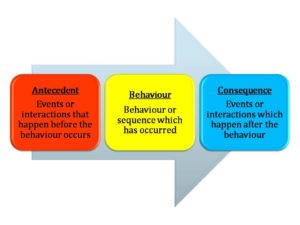ABA: OVERVIEW AND PROS
Applied behavior analysis (ABA), regarded by many to be the most effective evidence-based treatment for autism available, focuses on using techniques of learning that help promote positive behaviors and steer away from harmful or interfering ones. It has been endorsed by federal agencies as a safe and beneficial treatment, and there has been a recent surge in its use.

Concept of ABA
The basis of ABA centers around teaching skills through antecedent (teacher delivers an instruction), response (child’s response to instruction), and consequence (reward for correct response, repetition for incorrect response). There is plenty of evidence for the effectiveness of ABA in treating children with autism; in fact, hundreds of peer-reviewed studies spanning over 50 years have garnered support for the treatment. It is also individualized – each child goes through an in-depth assessment and a unique plan is developed, ensuring the best results for different individuals. Lastly, the benefits of ABA can be clearly measured through data collected. Techniques can “produce improvements in communication, social relationships, play, self care, school and employment” for autistic members of any age.
POINTS OF CONTROVERSY
Despite ABA’s many benefits, there are still naysayers to the treatment, many of which come from autism advocacy networks. The obvious question follows: if ABA is as supposedly beneficial as people say it is, why would disapproval come from the very group that wants the best for autistic individuals?

A therapist and child engaging in reward during ABA treatment.
There are several answers to this question, one of which is that the treatment is based on the outdated and false premise that autistic individuals should be treated or changed to become “normal”. Some members of autism advocacy groups feel that ABA does not necessarily support the acceptance of autistic individuals’ differences, and focuses too heavily on “fixing” these individuals. For instance, many ABA programs focus on reducing repetitive behaviors (ex: rocking back and forth, flapping hands). Teaching a young child that their movements and actions are wrong simply because they are different from the norm often has a damaging effect on the child. Ari Ne’eman, leading autism rights advocate and founder of Autistic Self Advocacy Network, states that ABA treatments focus on making autistic children appear as though they are “indistinguishable from their peers”.
Additionally, there is the concern that young children may just be memorizing certain behaviors rather than understanding the meaning behind them. One parent voiced that she did not want her son to “become a robot”, repeating phrases simply because he was taught that it was what he was supposed to do. It may also be harmful to the autistic child, who has to conform in terms of “socially acceptable” conversation topics, when many of them find it difficult or stifling not to talk about their special interest.
ABA AS A DOUBLE-EDGED SWORD
Ultimately, there is no clear answer as to whether the pros outweigh the cons and vice versa for applied behavior analysis. Personally, I can definitely see certain aspects of ABA to be viewed as outdated in several years’ time; however, the evidence of its benefits are indisputable and more effective than many other treatments. Both sides of the argument provide solid, convincing claims, and everyone’s outlook on whether or not to implement the treatment will be different depending on their values and goals.

The conflict between those supporting Applied Behavior Analysis and those against the treatment both bring up interesting ideas about Neurodiversity. The idea that this therapy will change an individual’s brain and take away from their individuality and unique characteristics completely clashes with the take-home message of the Neurodiversity movement. However, if children with autism could find a way to improve their ability to communicate and build strong relationships, their overall happiness and quality of life likely would be higher. I would be interested in exploring what children and adolescents who may have gone though or are going though this treatment have to say about the exercises. -scphillips01